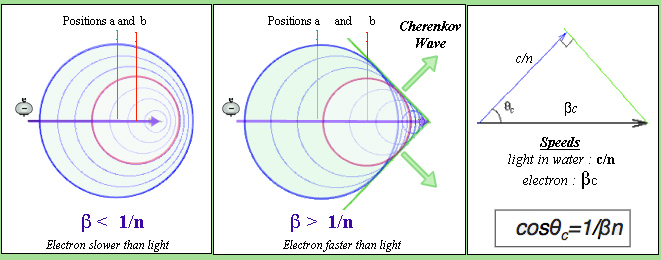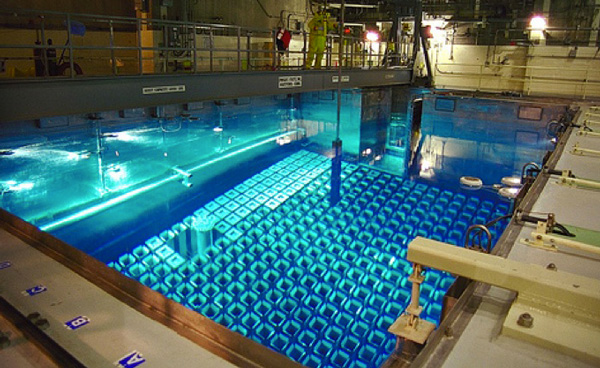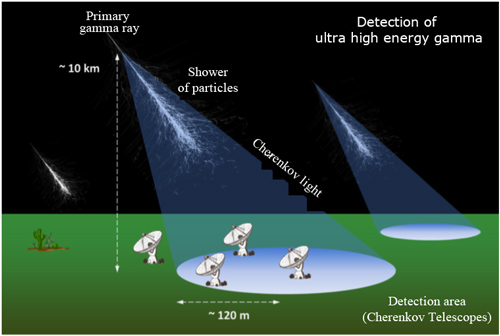When an electron goes faster than light in air and water …
The Cherenkov effect occurs when a particle carrying an electric charge travels through a transparent medium like water or air. If the particle travels faster than light in this medium, its passage causes a brief flash of light, a Cherenkov light.
The effect is named after the Soviet physicist Pavel Alekseyevich Cherenkov (1904-1990) who discovered the phenomenon and obtained the Nobel Prize in Physics for his discovery in 1958.
In the field of radioactivity, the particles concerned by the Cherenkov effect are electrons and positrons. Very light, they reach very high speeds. In water, the speed of light is 200,000 km / sec. An electron must have an energy greater than 175 keV to go faster than light in water. This condition is often fulfilled by beta electrons of radioactivity, but never with the heavy and too slow alpha particles.

The Cherenkov wavefront
On the left, are represented the waves emitted by an electron going slowler than light in water. The spherical light wave emitted in position (b) does not catch up with the one emitted previously in position (a). In the center, the electron goes faster than the light in the medium. The spherical waves catch up, generating a conical wave front which follows the corpuscle. On the right, the formula gives the angle of the Cherenkov wavefront with respect to the corpuscule direction as a function of its speed.
© IN2P3
During their journey, the corpuscles ionize and rattle the many atoms and molecules they encounter. The restoration of the medium is accompanied by the emission of de-excitation photons, for instance in water of visible photons of blue light. The emission of these photons does not cost much in energy: 2.5 electronvolts (eV) for a photon in the blue!
A 500 keV (500,000 eV ) electron that would spend all its energy in emitting blue photons would produce 200,000 of them! The path of the beta electrons in water is of the order of a few millimeters. On this very short course, the emitted photons are therefore very numerous. Photons are also elementary waves. These blue waves combine along the trajectory to form spherical light waves. If the electron goes faster than light in water, these spherical waves combine in turn into a conical wave front that accompanies the particle.
An electron that exceeds the speed of light resembles a fighter plane that crosses the sound barrier. As long as the plane has not exceeded the speed of sound, the sound waves announce its arrival. When it reaches a supersonic speed, the plane passes over our heads before the sound wavefront shakes the windows and vibrates our eardrums. The Cherenkov effect derives from an analogous principle: the electron plays the role of the airplane, the waves of light that of the sound waves.

Cherenkov blue light of nuclear cooling pools
The blue color of water that bathes fuel assemblies in storage pools is due to the Cherenkov light. A fraction of gamma rays coming from radioactive decays that occur in the fuel rods pass through the fuel cladding to reach water. These gamma rays produc in turn fast electrons by the Compton effect which are the source of the Cherenkov blue light.
© NRC
The Cherenkov light is responsible for the blue shade of the pools where the very radioactive spent fuel of nuclear power plants is stored. The cladding enclosing the fuel rods are leakproof and thick enough to stop the beta rays of radioactive decays. On the other hand, they let some gamma rays penetrating the storage pool. Interacting with water these gamma will produce electrons by Compton effect. If they are fast enough, these electrons will produce a flash of blue light by Cherenkov effect.

Identification of a cosmic shower nature
The shower of particles created in the upper atmosphere by a high energy cosmic particle generates a cone of Cherenkov light. A network of ground-based telescopes collects almost simultaneously parts of this light. The analysis of the gathered simultaneous information makes it possible to identify the nature of the shower, the direction of the axis of the Cherenkov cone and thus to go back to the direction of the primary particle.
© IN2P3/HESS
In the atmosphere, the speed of light is very close to 300,000 km / sec, the speed of light in a vacuum. An electron must have an energy greater than 21 MeV (21 million electronvolts!) to generate a flash of Cherenkov light. This condition is never fulfilled for the electrons of radioactivity.
Cosmic radiation, on the other hand, contains electrons, positrons and also very high energy muons that can produce Cherenkov light flashes. This Cherenkov light is used to detect cosmic showers.
The Cherenkov effect is used as a tool in many modern experiments: in nuclear physics (for instance to detect solar neutrinos); in high energy experiments such as the ones performed at CERN to identify the nature of particles; in the astrophysical experiments that study cosmic showers.
Other articles on the subject « Radiations effects in matter »
Charged Particle Effects
A gradual loss and transfer of energy Alpha rays, fission products ; heavy, slow and ionizing par[...]
Alpha Rays in Matter
An atomic bulldozer, strongly ionizing along a very short path Alpha particles are simultaneously[...]
Beta Rays in Matter
Light electrons : a chaotic journey through matter Beta electrons and positrons have equal and op[...]
Bremsstrahlung
A relativistic phenomenon that applies to electrons and positrons… The phenomenon of bremss[...]
Neutral Particle Effects
Energy transfer by proxy… Neutral particles that are of interest in the field of radioactiv[...]
Cross Section
Cross section or the interaction probability of a particle Cross section is the name given by phy[...]
Gamma Rays in Matter
Gamma can be attenuated but never fully stopped The neutral gamma rays leave very different effec[...]
Photoelectric Effect
The most effective mechanism of photon absorption The photoelectric effect is the phenomenon that[...]
Compton Effect
Photons as projectiles and electrons as targets The Compton effect is the name given by physicist[...]
Macroscopic Effects
Effects on inert or organic matter The ionisation of atoms surrounding the trajectory of an alpha[...]